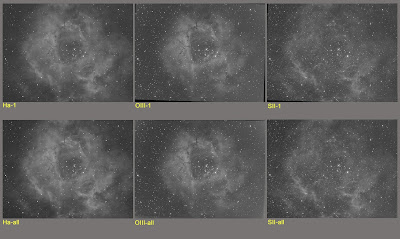My setup is as follows:
Camera: ZWO ASI1600MM-Pro
Telescope: Astro-Tech AT115EDT 115mm Refractor Telescope
Focal Reducer: Astro-Tech 0.8x Focal Reducer/Field Flattener for Refractor Telescopes
Mount: Orion Sirius
Filter Wheel: ZWO EFW 8x 1.25"
Autoguiding: QHY-5L-II-M attached to an Agena 50mm Guide Scope with Helical Focuser
Telescope: Astro-Tech AT115EDT 115mm Refractor Telescope
Focal Reducer: Astro-Tech 0.8x Focal Reducer/Field Flattener for Refractor Telescopes
Mount: Orion Sirius
Filter Wheel: ZWO EFW 8x 1.25"
Autoguiding: QHY-5L-II-M attached to an Agena 50mm Guide Scope with Helical Focuser
Other:
I have been using a gain setting of 139 since I started using the ASI1600 mainly because Gary Imm and Chuck Ayoub use 139, recently however, Gary recommended using 300 for NB imaging so I figured I would give it a try.
The comparison:
The following table lists the conditions each of the frames were were collected and they correspond to the images that follow. The single frames were opened in PI and only the STF function was run on them so they could be compared in there most basic state. They were saved as tiff files and imported into PS so they comparison table could be made. The stacking was done in PI and again, only the STF function was run on the images.
For more checkout the video:
https://youtu.be/9AvPAGezNpk
The following table lists the conditions each of the frames were were collected and they correspond to the images that follow. The single frames were opened in PI and only the STF function was run on them so they could be compared in there most basic state. They were saved as tiff files and imported into PS so they comparison table could be made. The stacking was done in PI and again, only the STF function was run on the images.
For more checkout the video:
https://youtu.be/9AvPAGezNpk
Ha
|
OIII
|
SII
| |
Single 1
|
87% moon
~ 40° angular dist.
|
35% moon
~ 35° angular dist.
|
35% moon
~ 35° angular dist.
|
Single 2
|
99% moon
~ 60° angular dist.
|
99% moon
~ 60° angular dist.
|
99% moon
~ 60° angular dist.
|
Stacked with 1 only
|
87% moon
~ 40° angular dist.
|
35% moon
~ 35° angular dist.
|
35% moon
~ 35° angular dist.
|
Stacked with 1 and 2
|
Both
|
Both
|
Both
|
Single Frame
Conclusions:
I thought I was not going to be able to use the additional data collected when the moon was much brighter as the frames examined in PI - Blink looked much worse than the lower moon frames. However, after looking at all the frames and data together, I am glad I kept everything because it looks like the additional frames added some beneficial detail.
The individual Ha data looks almost the same from both nights which makes sense since their intial conditions were close. The OIII was affected most by the moon shine but still the stacked image using both sets of data looks a bit better. The SII also shows a bit of degradation with the moon shine but not as much as the OIII. Again, the stacked image is still better.
Anyways, I am glad I did this little experiment so I have a better understanding. Although collecting when the moon is out it is not great data, it is better than not collecting data.
Data:














No comments:
Post a Comment